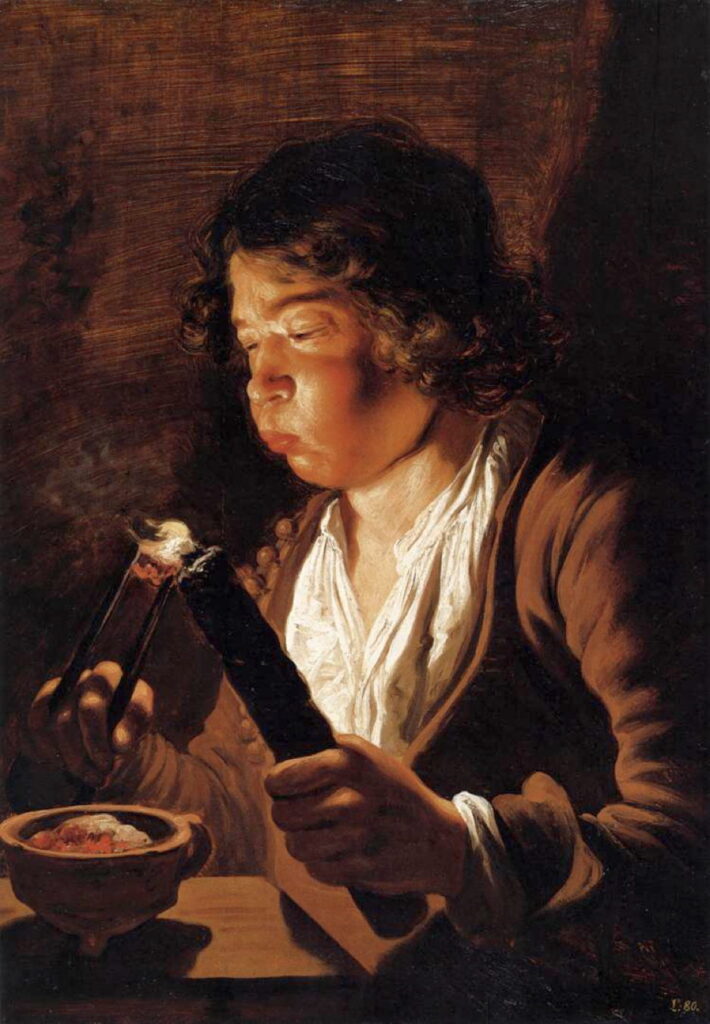Reading visual art: 108 Candles as symbols

Candles are another ancient source of light, alongside oil lamps. They’re traditionally made from fats that solidify at room temperature, derived from animals and, more recently, from paraffin wax. For a while during the eighteenth and nineteenth centuries the best candles were made from spermaceti, extracted from the sperm whale, but thankfully they were replaced by paraffin wax derived from coal and oil shales.
Candles were used by the Romans from about 500 BCE, but never really earned themselves a prominent place in classical myth. They became incorporated into the Christian faith, most notably in the feast of Candlemas, commemorating the presentation of Jesus at the Temple, and celebrated most commonly on 2 February.
Teodor Axentowicz (1859–1938), Dziewczyna z gromnicą (Girl with the Blessed Candle) (date not known), oil, 32 x 24 cm, Muzeum Sztuki w Łodzi, Łódź, Poland. Wikimedia Commons.
Teodor Axentowicz’s undated Girl with the Blessed Candle shows a young Hutsul woman holding a candle that has just been blessed, as she makes her way through the snow on Candlemas Day, which takes place after Theophany and concludes the traditional Christmas season. Once blessed, the candle is kept in the house and burned over the following year.
Most branches of the Christian church also use votive candles when offering up prayers. These may have been inspired by the description of Jesus Christ as the Light of the World, and are more formally used in ceremonies such as pilgrimages known as pardons.
Pascal Dagnan-Bouveret (1852–1929), The Pardon in Brittany (1886), oil on canvas, 114.6 × 84.8 cm, Metropolitan Museum of Art, New York, NY. Wikimedia Commons.
Like the older Jules Breton, Pascal Dagnan-Bouveret became fascinated by these pardons taking place in Brittany, but doesn’t seem to have attempted to paint large gatherings of pilgrims in a full-scale pardon, like Breton. His first painting showing a pardon was completed in 1886, as The Pardon in Brittany. He shows men and women of all ages walking barefoot, holding lighted candles. The older man with a stick to the left of centre is strongly reminiscent of some in Breton’s earlier paintings of pardons.
Processions bearing lighted candles have also become a feature of funeral rites.
Teodor Axentowicz (1859–1938), Pogrzeb huculski (Hutsul Funeral) (1882), oil on canvas, 86 x 115 cm, Private collection. Wikimedia Commons.
Axentowicz’s oil painting of a Hutsul Funeral from 1882 shows the people in the rigours of winter in the Carpathian mountains. The coffin is being towed on a sledge behind a cart, and the mourners clutch candles as they make their way through the snow to the stave church in the distance.
Jean-Paul Laurens (1838–1921), Funeral of William the Conqueror (1876), oil on canvas, dimensions not known, Musée des Beaux-Arts de Béziers, Béziers, France. Image by Tylwyth Eldar, via Wikimedia Commons.
In 1876, Jean-Paul Laurens painted the Funeral of William the Conqueror. King William I, sometimes referred to as William the Bastard, was the Duke of Normandy when he invaded England in 1066. He defeated King Harold at the Battle of Hastings, and in that led the Norman Conquest. He fell ill or was injured when fighting the French for Mantes in July 1087, and was taken to Rouen, where he died on 9 September.
Extinguishing or snuffing out a candle also has special significance in the act of excommunication, as depicted by Laurens the previous year.
Jean-Paul Laurens (1838–1921), Excommunication of Robert the Pious (1875), oil on canvas, 130 x 218 cm, Musée d’Orsay, Paris. By Rama, via Wikimedia Commons.
Robert II (972-1031), also known as Robert the Pious or Wise, ruled the Franks from 996 until his death. Notoriously religious, he conducted a long campaign against heretics, supporting riots against the Jewish community of Orléans, and burning heretics at the stake. However, he was less successful in marriage. His first (arranged) marriage to Rozala of Italy ended in divorce around 996, following which he married Bertha of Burgundy, his cousin.
Pope Gregory V refused to sanction the marriage. Robert’s refusal to annul the marriage led to his excommunication, which was performed in full mediaeval style, ‘with bell, book, and candle’. That involved the tolling of a bell, closure of the Book of the Gospels, and snuffing out a candle, in a formal ceremony. Long negotiations with the next Pope, Sylvester II, were unsuccessful, and Robert’s marriage to Bertha was eventually annulled.
Excommunication of Robert the Pious (1875) shows King Robert II sat on his throne, with Bertha huddled next to him, as the procession of clerics leaves the room. The only sign providing any clue to what might have happened is a very large candle resting on the floor in front of the couple, having just been snuffed out.
In myths, candles are notably associated with witchcraft.
Eglon Hendrik van der Neer (1634–1703), Circe Punishes Glaucus by Turning Scylla into a Monster (1695), oil on canvas, 64 x 53.3 cm, Rijksmuseum Amsterdam, Amsterdam, The Netherlands. Wikimedia Commons.
Eglon van der Neer’s Circe Punishes Glaucus by Turning Scylla into a Monster from 1695 is one example. The sorceress Circe takes the limelight, as she casts her potion from a flaming silver salver held in her right hand. Dripping onto that is the wax from a large candle, held in her left hand. In the water below, Scylla has already been transformed into a gorgonesque figure, with snakes for hair, and the grotesque Glaucus watches from behind. Above and to the right of Circe is a small dragon perched on a rock ledge.
Dosso Dossi (–1542), Melissa (Circe) (c 1518-1531), oil on canvas, 176 × 174 cm, Galleria Borghese, Rome. Wikimedia Commons.
Dosso Dossi’s painting of the sorceress Melissa (c 1518-1531), from Orlando Furioso, is set in a richly detailed landscape. She sits inside a magic circle, around which are inscribed cabalistic words, and lights a large candle held in her left hand. In the upper left corner are small homunculi apparently growing on a tree. On the left is a large dog, and perched on top of a suit of armour is a bird, most probably a woodpecker.
Candles are sometimes seen in allegories.
Jan Lievens (1607-1674), The Four Elements and Ages of Man: Fire and Childhood (1624), oil, 83 x 58 cm, Museumslandschaft Hessen Kassel, Kassel, Germany. Wikimedia Commons.
In 1624, Jan Lievens brought the four ages of man together with the elements in a unique series. This is his Fire and Childhood, an example of chiaroscuro used to model real lighting conditions. The boy is using a glowing coal held in tongs to light the wick of a candle.
El Greco (1541–1614), An Allegory with a Boy Lighting a Candle in the Company of an Ape and a Fool (Fábula) (1589-92), oil on canvas, 67.3 x 88.6 cm, Scottish National Gallery, Edinburgh, Scotland. Wikimedia Commons.
El Greco’s An Allegory with a Boy Lighting a Candle in the Company of an Ape and a Fool (Fábula) from 1589-92 deliberately exaggerates the light of a glowing coal being used to light a candle to heighten effect in telling this obscure fable.
Snuffed-out candles can be a distinctive feature of Vanitas paintings, which became popular during the Dutch Golden Age. Here they refer to life being snuffed out, in an often bizarre collection of symbols associated with weariness of the world and yearning for death.
David Bailly (1584–1657), Self-Portrait with Vanitas Symbols (1651), oil on panel, 65 x 97.5 cm, Museum De Lakenhal, Leiden, The Netherlands. Wikimedia Commons.
David Bailly’s Self-Portrait with Vanitas Symbols (1651) contains multiple portraits referring to the past. The figure shows the artist as a younger man, holding the maulstick he used in painting. His actual self-portrait at the time is in the painting he’s holding with his left hand. Next to that is a painting of his wife, who had already died, and a ghostly image of her is projected onto the wall behind the wine glass.
Gathered in front of the artist are ephemera and other signs of vanitas: the snuffed-out candle, a glass of wine, flowers, and soap bubbles, together with a string of pearls and a skull. If that message isn’t clear enough, he provides the quotation on a piece of paper: vanitas vanitum et omnia vanitas, “vanity of vanities, and all is vanity”, together with his signature and date.
Carstian Luyckx (1623–after 1657), Allegory of Charles I of England and Henrietta of France in a Vanitas Still Life (date not known), oil on canvas, dimensions not known, Birmingham Museum of Art, Birmingham, AL. Image by Sean Pathasema, via Wikimedia Commons.
Carstian Luyckx includes a wide range of symbolic objects in his undated Allegory of Charles I of England and Henrietta of France in a Vanitas Still Life. These include a globe, the physical world itself, the gall from a tree, a snuffed-out candle, seashells, and coral. He uses another common device found in Vanitas painting: an open book, here showing King Charles I, who was executed in 1649, and his wife Henrietta Maria of France, who was deposed as queen of England by the civil wars, forcing her to flee to France in 1644.

